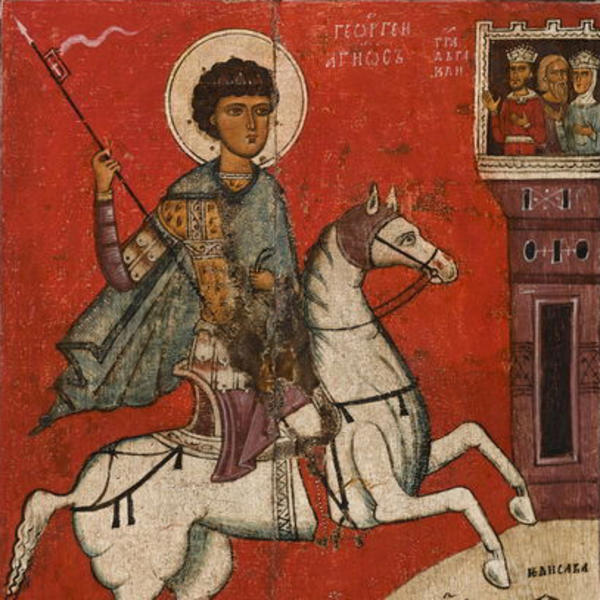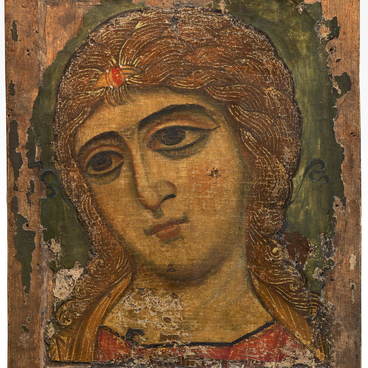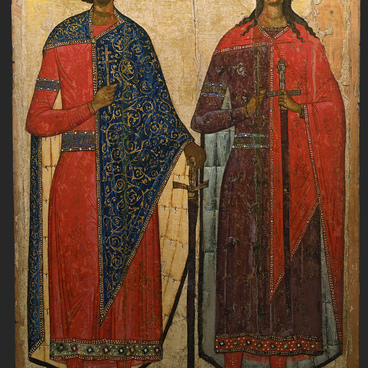The Miracle of St. George and the Dragon icon is the earliest vita image of St. George in ancient Russia. It was created by an unknown artist in Novgorod in the first half of the 14th century. And as Novgorod did not suffer destruction during the Mongol rule in the 13th-15th centuries, the icon has survived to these days. The city has preserved traditions and heritage of the old Russian art.
The Miracle of St. George and the Dragon
Creation period
First half of the 14th century
Dimensions
86x63 cm
Technique
Wood, levkas primer, tempera
Collection
Exhibition
42
Open in app#3
Unknown Author
The Miracle of St. George and the Dragon
#2
#4
Hagiographic icons are mediaeval versions of the saints’ lives. As a rule, those images have the centerpiece and border scenes. The border scenes are separate, more often than not rectangular, panels of the icon complementing the story in the centerpiece.
#5
This icon tells the story of Byzantine St. George, or St. George the Victorious, one of the most revered Christian saints. The most popular legend tells us about St. George saving the Lebanese princess Yelisava from a serpent, or dragon that terrified all Lebanese people. Having witnessed the miraculous victory, the local people converted to the Christian faith.
#7
This episode in the hagiography of St. George has a symbolic interpretation as well: the princess represents the Church, while the serpent is an allegory of paganism or even the devil himself. Slaying the dragon, George delivered the Christian Church from pagans and evil powers.
#6
The central part of the icon depicts St. George himself, on a white horse, in armour and a cloak, holding a lance. The princess leads the dragon, pacified by the prayer, “like a sheep” into the town. The king, queen and their subjects are observing the miracle from the palace window.
The Miracle of St. George and the Dragon, with the saint’s life in 14 border scenes. The centerpiece.
#8
The lore has it that George served in the army of the Roman emperor Diocletian who ruled between 284 and 305 AD. At the time when Rome started persecuting Christians, George, coming from a wealthy family, distributed all his inheritance among the poor. This scene is depicted in one of the 14 border panels.
#10
Despite his distinguished service, in 303 AD, after cruel torture, George was executed for his Christian faith. Most of the side scenes tell stories of his martyrdom — ‘passions’. According to Eastern texts, prayers helped the saint to survive eight days of torture. The lances of the sentinels would break, the saint’s wounds would heal, while poison or fire would not harm him.
#11
St. George the Dragon Slayer set the Christians an example of fortitude and courage. In ancient Russia the saint was venerated as the patron saint of warriors, farmers and brides. Unsurprisingly, his image has been often used in heraldry. St. George the Victorious today can be seen in the national emblem of the Russian Federation, and on the coats of arms of Moscow and a number of other Russian cities.
Moscow’s coat of arms
#12
Until 1851 the icon belonged to Mikhail Pogodin, a Moscow historian, writer and collector. It was later kept in the Synodal Sacristy and the Myrrh Preparation Chamber of the Moscow Kremlin. In 1870 the icon was donated to the Museum of the Academy of Arts, and since 1898 The Miracle of St. George and the Dragon has been in the collection of the Russian Museum.
#13
State Russian Museum
read morehide
00:00
00:00
1x
The Miracle of St. George and the Dragon
Creation period
First half of the 14th century
Dimensions
86x63 cm
Technique
Wood, levkas primer, tempera
Collection
Exhibition
42
Open in app
Share





